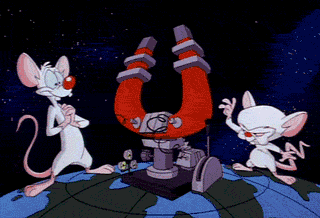Executive produced by Steven Spielberg in the 1990s, Animaniacs was an award-winning series that caught the attention of a wide-ranging audience with their mix of youthful exuberance and nods to adults watching the show with their highbrow parodies and references. The show, which delivered in a sketch comedy format—and featured the Warner Brothers and Sister characters, Yakko, Wakko, and Dot, and spawned other memorable breakout characters like Hello Nurse and Pinky and the Brain—was one of the most imaginative and ambitious animated shows on television. To celebrate Animaniacs and the release of The Hundreds X Animaniacs tomorrow, here are 9 things you might not have known about the series:
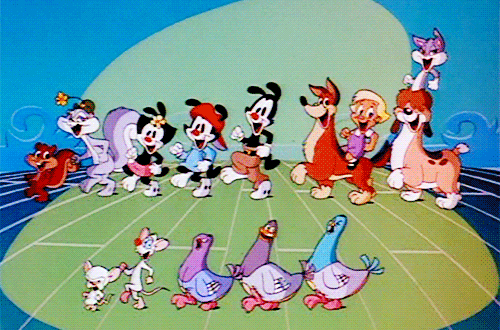
Pinky & The Brain were based on creator Tom Ruegger’s co-workers because they always sounded like they were plotting to take over the world.
Pinky and The Brain were two genetically enhanced laboratory mice who lived inside Acme Labs with the most ambitious goal two lab rats could ever dream of attaining: to take over the world. Brain was, well, the brain of the operation, while Pinky often had the best intentions but often got in the way of Brain’s plans with his lack of awareness. (Although fan theories exist that Pinky’s observations in Brain’s flawed plans prove that Pinky is actually the genius).
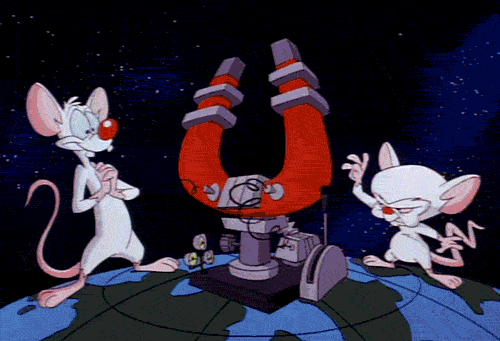
Pinky and The Brain were so popular they got their own spin-off animated series in 1995. What many people might not know is that their characters were actually inspired by Ruegger’s co-workers. Pinky was based on Eddie Fitzgerald, a Warner Bros. Animation Director, who actually said “Narf!” and “Egad!” in real life, two of the catchphrases that Pinky used in Animaniacs. Brain was based on Tom Minton, a Warner Bros. Animation Artist and writer. Here’s a real life photo of them below. I must say, the resemblance is uncanny.

Yakko, Wakko, and Dot were inspired by Ruegger’s three young sons.
Pinky and Brain were inspired by Ruegger’s co-workers, but inspiration for the main characters on Animaniacs came from a more personal place for the show’s creator. Yakko, Wakko, and Dot were inspired by Ruegger’s three sons: Nathan, Luke and Cody. Wakko, the middle child of the three Warner siblings, voiced by Jess Harnell, who modeled Wakko’s voice after famous Beatles member Ringo Starr. In another fun bit of trivia, the voice actor for Yakko is Rob Paulsen, who also voiced Pinky of Pinky and The Brain.
The famous “Yakko’s World” song was recorded in one take.
Even those who didn’t watch Animaniacs have probably heard of “Yakko’s World,” in which the character voiced by Rob Paulsen listed every single country on the map, at that time, in song form! The idea for “Yakko’s World” came from Animaniacs writer Randy Rogel, who was helping his son with his geography homework when he realized “United States, Canada, Mexico, Panama” worked as a rhyme. He set the rest of the song to the tune of “The Mexican Hat Dance Song” and the rest was history.
The most impressive thing about “Yakko’s World” is that Paulsen said in an interview earlier this year that he recorded the song in one take. Seriously, I dare any of you to try and get through the lyrics of the song without stumbling in one take. You can’t!
Animaniacs always pushed the boundaries of irreverent humor when it could.
While Animaniacs worked perfectly fine as a show for younger viewers, the older audience of the show—one-fifth of the viewers in 1995 were 25 years or older—could enjoy the show on several levels, as Animaniacs rarely shied away from pushing the boundaries of irreverent humor on the show.
There’s an ultimate compilation of these innuendoes on Youtube.

Animaniacs was also the best at parodying other television shows and movies.
Animaniacs was also the king of parodies. Along with The Goodfeathers, a pigeon parody of The Goodfellas, popular television shows that were spoofed included Friends, The Power Rangers, and Rugrats. Disney movies didn’t escape Animaniacs’ wrath either, including The Lion King and Beauty and the Beast. The parodies were a fun homage to the television shows and movies that were popular at the time.
Russell Calabrese, a director on the show, once said: “Art imitates life. Life imitates art. To be parodied on Animaniacs would be taken as a badge of honor.”
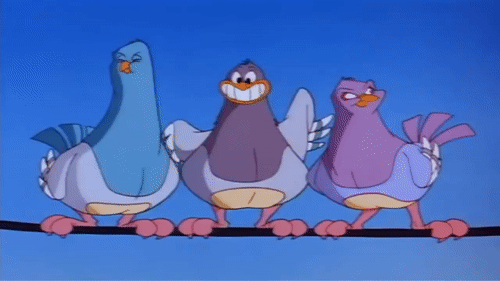
One of the best recurring segments on the show, Wheel of Morality, was actually created to fill time whenever an episode ran short.
The Wheel of Morality segment appeared plenty of times over the course of Animaniacs. It involved Yakko, Wakko, and Dot coming upon a Wheel of Fortune style wheel, spinning it, and getting a moral lesson out of it.
Like most segments on the Animaniacs, the backstory of it is just as hilarious as the execution on the show. The segment was actually used to fill in time for episodes that ran short, and was satire for the FCC’s requirement to always have some sort of moral and educational value in children’s programming.
Among the best lessons learned from the Wheel of Morality: if at first you don’t succeed, blame your parents, vote early and vote often, don’t eat with your mouth full, and people who live in glass houses should get dressed with the lights out.

Animaniacs had a full 35-piece orchestra to play original scores for the entire series.
Aside from its genius scripts and hilarious characters, one thing that set Animaniacs apart from other animation series in the 1990s was its attention to detail, especially with their music. For an animation series, Animaniacs was a full production—and spent a lot of time on making sure every episode featured at least one original score. This was something that Steven Spielberg pushed at the inception of Animaniacs, and Warner Bros. was supportive of the series’ unique creative process. Animaniacs had a 35-piece orchestra and contracted seven composers to write original scores for the entire run of their show. A personal favorite of mine was “Slippin’ On The Ice.”
This made Animaniacs a very expensive show to produce—the music, the writing, the sound quality, and even the higher cel count during the animation process (which made the characters move fluidly, unlike other TV cartoons at the time) was reminiscent of the Golden Age of Animation‘s production value. No wonder the show ended up landing an Emmy and Peabody award.
The original promotion of Animaniacs involved Mickey Mouse, kind of.
As a way to promote Animaniacs, people involved in the show decided to put a giant balloon version of Yakko at the top of the actual water tower at the Warner Bros. lot in Burbank.
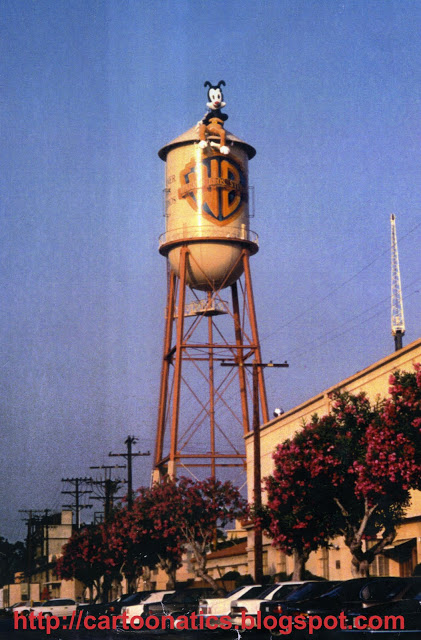
There was one problem, though. Bob Daley, who ran Warner Bros. Studio at the time, was not clued in on the plan. From far away, Yakko looked like Mickey Mouse, and Daley thought someone had pulled a prank and put Mickey at the top of the water tower, so he had the balloon version of Yakko removed. After the incident, Daley had Ruegger add whiskers to Yakko, Wakko and Dot and ensured that they didn’t look too similar to Mickey Mouse. So, the entire balloon incident ended up serving a purpose on shaping the final version of the main characters on Animaniacs.
The writers came up with a ton of ideas that ended up unused.
With so many talented people in the writers’ room churning out different sketches and larger ideas for the show, it’s no surprise that plenty of gems ended up on the cutting room floor. Randy Rogel, the genius behind “Yakko’s World,” had another song he wrote for the show called “The Geologic Clock” which would have involved Yakko singing about the entire history of Earth. It is fun to think about whether this would have done as well as “Yakko’s World.”
“As The Petri Dish Turns” was a soap opera parody that the writers conceived based on the popular series As The World Turns. Except, in typical Animaniacs fashion, they were aiming to turn the soap opera genre upside down. This parody would have followed the lives of microscopic organisms, and how cell division would impact the relationship between these organisms. The concept itself sounds hilarious on paper, but never made it onto the show.
***

